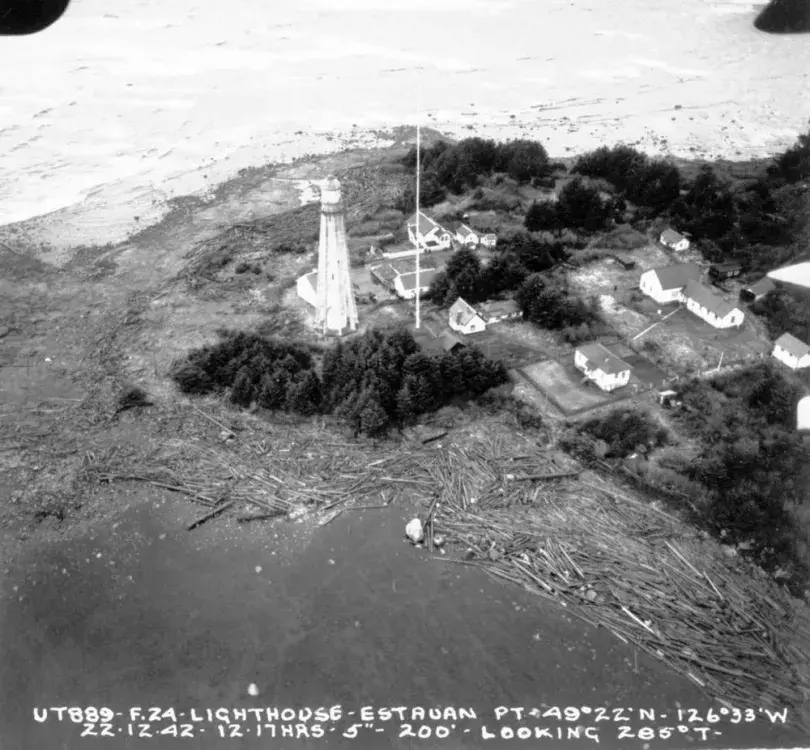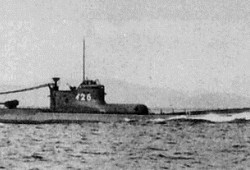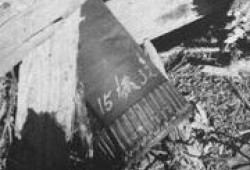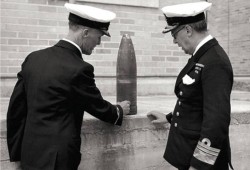It was late in the evening on June 20, 1942, when the Japanese submarine I-26 shelled the Estevan Point Lighthouse and the Dominion government’s radio telegraph station. The incident occurred on the Hesquiaht First Nation’s former main village on the west coast of Vancouver Island.
Nobody was hurt and no damage was done to the lighthouse, but the incident marked the first time enemy militants attacked Canadian soil since the War of 1812, according to official reports.
Yvonne Lucas recounts the story her late husband Harry Lucas, who was a newborn at the time, heard from his mother:
“The whole reserve was so panicky and scared. They all ran into the bushes. Harry said his mom ran in there with him upside down, she was holding him. They were so scared,” Lucas shared, adding that Harry was born on April 8, 1942.
“Nothing was damaged. They were just scaring them. Nobody got hurt. I think it was just a warning from the Japanese,” Lucas added. “The whole tribe ran into the forest because they didn’t know what was going on.”
Hesquiaht elder Dolores Bayne (Muuhaykwilth) says her grandmother Susan Francis Paul, who was born in the late 1800’s, told her stories about the night the Japanese attacked Hesquiaht shores.
“She was the one that raised us kids. When the loud noise started, they all ran out. They got really scared. Somebody said, ‘They are shooting at us!’ Not realizing that it might be bombs. They all scrambled for their canoes, taking some provisions as fast as they could,” said Bayne.
“Kind of a funny story in there too,” she continued. “My grandfather and his wife they were all yelling, and taking kids, scrambling, and my grandfather was hollering for his wife, and she dropped her tobacco can, and it was floating here and there, and she was trying to go after it.”
Baynewas born at the Kakawis Indian Residential School on Meares Island.
“They had what they call a visitor room and I was born there in 1939. They were on their way to Hesquiaht,” said Bayne.
She told the Ha-shilth-sa that her grandmother also used to talk about planes going over Hesquiaht.
“They got scared of that too, I don’t know why there were so many flying over, they were investigating the submarine that was doing the bombing,” said Bayne.
Hesquiaht Chief Councillor Mariah Charleson remembers hearing her dad Stephen Charleson talk about the shelling of Estevan Lighthouse with her grandma Jean Charleson.
“I think the scary thing for me is the whistling sound; she remembers the loud sounds and seeing the shells above the village. I feel like that would be absolutely frightening,” said Charleson.
“Grandma Jean told my dad that they went to the canoes and then into the fishing boats and they all tied up in the boat basin until they figured it was safe to go back home. When they returned home, they checked on everything to make sure that it was fine, and then I guess the next day then went to Ahousaht where they figured it would be safer,” she said.
Charleson wasn’t sure how many Hesquiaht members ran into the woods or how many went to the water that night, but either way, she says “they had to be quick acting”.
Hesquiaht’s former village site is relatively close to the Estevan Lighthouse, which is why they could hear the whistling of the bullets.
“When you look south you can see the light from the lighthouse,” Charleson said.
Twenty-four hours after the attack on Estevan Point, it was reported by the British United Press (BUP) on June 22, 1942, that “an unidentified craft, probably a Japanese submarine, hurled shells onto the shore of northern Oregon.”
“Between six and nine shots were fired by last night’s submarine at the coast in the vicinity of Seaside, Ore., at 11:30 p.m., the army communique said. The shelling continued for 15 minutes,” the BUP article reads. “The army said no damage or casualties resulted.”
The pair of Japanese naval attacks on the Pacific Coast came six months after Japan’s aerial assault of Pearl Harbor, Hawaii on Dec.7, 1941. The surprise air attack on America’s eastern Pacific naval base killed more than 2,400 souls and the United States, a previously reluctant nation, declared war on Japan and entered the Second World War.
Following Pearl Harbor, the United States and Canada forcibly relocated people of Japanese descent to internment camps, without any charge or due process. Japanese Canadians were required to turn in their fishing boats, their homes and their businesses, which were later sold by authorities.
“In war, truth is the first casualty,” said the ancient Greek philosopher Aeschylus.
Generations after the attack on Estevan Point, speculation surfaced that the Japanese might not have been responsible. In 1995, The Fifth Estate, CBC’s investigative documentary program, aired a story that questioned the official story. Eyewitnesses interviewed suggested the shelling was a government conspiracy by the Canadian and Americans to drum up support for conscription.
Official Naval Historians Michael Whitby and Bill Rawling, with Canada’s Department of National Defence, said in a 2004 article from the Ottawa Citizen that any suggestions that Canada and America staged the attacks are “unfounded and flies in the face of rigorous historical research.”
“Two Japanese submarines (I-25 and I-26) were sent to the Pacific coast of North America in June 1942 to reconnoitre the main United States base at Seattle and to give warning if American warships sailed against the attacks on Midway and the Aleutian Islands,” said the Naval Historians Whitby and Rawling. “Japanese naval doctrine at the time decreed that its submarines leave a calling card by shelling shore facilities upon departing their patrol areas, presumably in an attempt to stir up the local populace.”
In August 1945, America dropped atomic bombs on the Japanese cities of Hiroshima and Nagasaki, instantly killing hundreds of thousands of civilians. Japan surrendered and the Second World War came to an end on Sept. 2, 1945.
Bayne, who is the last living sibling amongst her four sisters and two brothers, says they always “hope that the time won’t come that another bomb goes off.”
“In seconds, we’ll be gone. The world will be starting over. When we think about it, we do a lot of praying,” said the Hesquiaht matriarch.
Editor's note: Yvonne Lucas passed away on November 9, 2024, after this article was written. Ha-Shilth-Sa will always remember her strong sense of history and how she enriched the cultural understanding of those she connected with.











